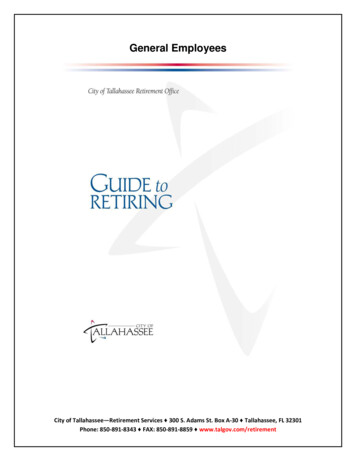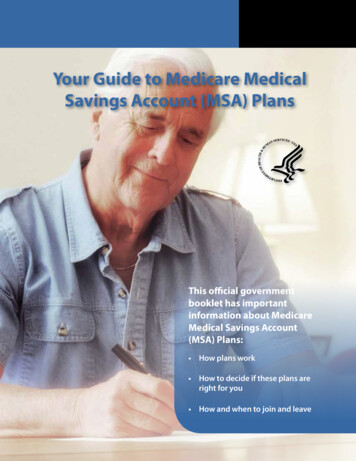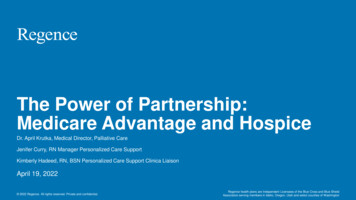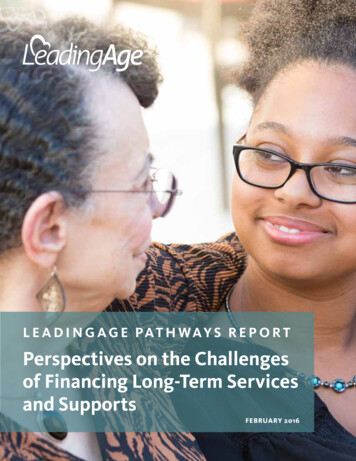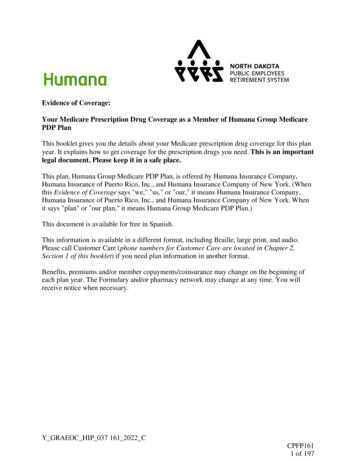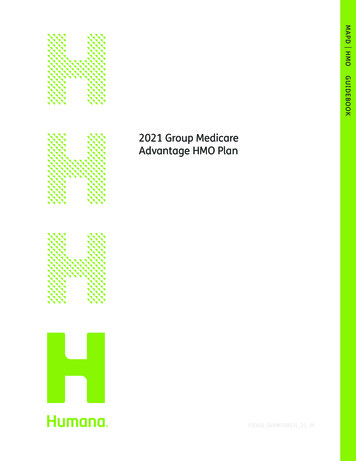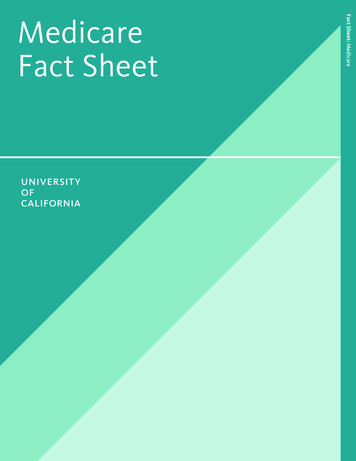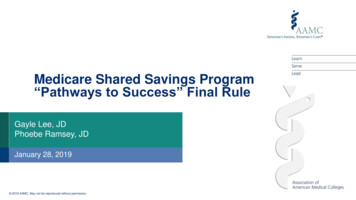
Transcription
Medicare Shared Savings Program“Pathways to Success” Final RuleGayle Lee, JDPhoebe Ramsey, JDJanuary 28, 2019 2019 withoutwithoutpermission.permission.
Contact InformationGayle Lee – galee@aamc.orgDirector of Physician Payment and QualityPhoebe Ramsey – pramsey@aamc.orgSenior Regulatory Analyst, Quality & Payment Policy2 2019 AAMC. May not be reproduced without permission.
Agenda Redesigning Participation Options to Facilitate Performance-Based Risk Benchmarking Methodology Refinements Annual Risk AdjustmentRegional Adjustment Blends & Growth FactorBenefit Enhancements & Tools to Strengthen Beneficiary Engagement 3Two Tracks: BASIC and ENHANCEDOptions Based on FFS Revenue & Prior ParticipationAnnual ElectionsRequirements for Participation in Two-Sided RiskPayment Consequences of TerminationSNF 3-Day Rule Waiver & Telehealth ServicesIncentive Payment Programs & Notifications 2019 AAMC. May not be reproduced without permission.
Key Highlights of the Rule Five year agreement periods BASIC and ENHANCED Tracks replace Tracks 1, 1 , 2, and 3 Reduces amount of time an ACO may participate without taking ondownside risk (generally 1-2 years, with a limited exception) Differentiates between ACOs on basis of revenue and prior experiencein terms of options for participation Accelerates use of regional adjustments to historical benchmarks &reduces maximum weight of regional adjustment Caps positive risk adjustment to benchmark for growth in risk scores to3%, but no cap on negative adjustment for decrease in risk scores Greater flexibility to use telehealth and the SNF 3-Day Rule Waiver forACOs in downside risk; flexibility to create a beneficiary incentiveprogram (BIP)4 2019 AAMC. May not be reproduced without permission.
Rulemaking ProcessThe “Pathways to Success” Proposed Rule was published in the FederalRegister on August 17, 2018 (83 Fed. Reg. 41786)Finalized policies split between CY19 Physician Fee Schedule FinalRule and “Pathways” Final Rule, which were published in the FederalRegister on November 23, 2018 (83 Fed. Reg. 59940) and December 31,2018 (83 Fed. Reg. 67816) respectivelyFinalized policies will take effect in 2019, unless otherwise noted.5 2019 AAMC. May not be reproduced without permission.
Redesigning Participation Options6 2019 AAMC. May not be reproduced without permission.
Past ACO Participation OptionsTrack 1MSSPTrack 2Track 3ACOCMMI ACOmodelsTrack 1plusNext Gen7 2019 AAMC. May not be reproduced without permission.
Pathways to Success Options (5 year terms)Level ALevel BBASICLevel CENHANCEDLevel DMSSPLevel E8 2019 AAMC. May not be reproduced without permission.
Two Tracks: Risk9 2019 AAMC. May not be reproduced without permission.
Example of Loss Sharing Limit Under BASIC Level E(2019, 2020)ACO’s Total UpdatedBenchmarkExpenditures:ACO’s Participant’sTotal Parts A and BFFS Revenue: 93,411,313 13,630,9834 percent ofBenchmark:8 percent ofRevenue: 3,736,453 1,090,479An ACO’s Loss Sharing Limit will be revenue-based, unless that figure exceeds thebenchmark-based limit.10 2019 AAMC. May not be reproduced without permission.
Participation OptionsAn ACO applying for a July 1, 2019 start (or a future January 1,2020 start) will be assessed on the following: Low FFS Revenue vs. High FFS Revenue; and Inexperienced vs. Experienced (with performance-basedrisk); and New ACO vs. Re-Entering ACO vs. Renewing ACO11 2019 AAMC. May not be reproduced without permission.
Participation Options: Revenue StandardCompares the following figures from the most recent CY for which 12months of data are available:Total Medicare Parts A and B FFS revenue* of the ACO’s Participants (TINs)toTotal Medicare Parts A and B FFS expenditures of ACO’s assigned beneficiaries High Revenue: FFS revenue is at least 35% of expenditures Low Revenue: FFS is less than 35% of expenditures*Calculation of FFS revenue differs from calculations for benchmarking: INCLUDES hospital add-on payments (IME, DSH, uncompensated care payments); and NOT TRUNCATED at 99th percentile of national Medicare FFS expenditures12 2019 AAMC. May not be reproduced without permission.
Participation Options: Experience StandardAn ACO is Experienced with Performance-Based Risk if either:1.ACO is same legal entity as current or previous ACO that is participating in, or hasparticipated in a performance based risk Medicare ACO initiative; OR2.40 percent or more of the ACO’s Participants participated in a performance-basedrisk Medicare ACO initiative in any of the 5 most recent performance years prior tothe agreement start.Track 1 Track 2Track 3BASIC13 2019 AAMC. May not be reproduced without permission.Next GenModelENHANCEDCEC(ESRD)Model
Participation Options: Entity StandardRenewing ACO: ACO that continues its participation in the program for aconsecutive agreement period (without a break in participation). Thisincludes ACOs that terminated current agreements and immediately entera new agreement to continue participation in the program.Re-Entering ACO: Either the same legal entity as an ACO (ACO-levelTIN) that previously participated in the program and is applying toparticipate after a break in participation OR a new legal entity applying toparticipate in the program where more than 50% of its ACO Participantspreviously participated in the program in the same ACO in any of the 5most recent performance years prior to the agreement start date.New ACO: An ACO who has never participated in the program and doesnot meet the definition of a re-entering ACO based on prior participationby its ACO Participants.14 2019 AAMC. May not be reproduced without permission.
Low Revenue ACO Participation OptionsEntity TypeExperienceParticipation OptionsNew ACOInexperiencedBASIC Levels A-E or ENHANCED*New ACOExperiencedBASIC Level E or ENHANCEDRe-Entering ACOInexperiencedBASIC Levels B-E or ENHANCEDRe-Entering ACOExperiencedBASIC Level E or ENHANCEDRenewing ACOInexperiencedBASIC Levels B-E or ENHANCEDRenewing ACOExperiencedBASIC Level E or ENHANCED*Exception for inexperienced, new, low revenue ACOs – can elect to enter BASIC Level A and remain inLevel B for a third PY if the ACO agrees to jump to Level E for the remainder of the agreement period.5 year agreement period would look like: A – B – B – E – E (instead of A – B – C – D – E)15 2019 AAMC. May not be reproduced without permission.
High Revenue ACO Participation OptionsEntity TypeExperienceParticipation OptionsNew ACOInexperiencedBASIC Levels A-E or ENHANCED*New ACOExperiencedENHANCEDRe-Entering ACOInexperiencedBASIC Levels B-E or ENHANCEDRe-Entering ACOExperiencedENHANCEDRenewing ACOInexperiencedBASIC Levels B-E or ENHANCEDRenewing ACOExperiencedENHANCED**ONE-TIME Exception for experienced, renewing, high revenue ACOs – if currently in Track 1 , ACO canelect to terminate current agreement and renew for a 5-year agreement under BASIC Level E (essentially5 years at the same level of risk as Track 1 )16 2019 AAMC. May not be reproduced without permission.
Permitting Annual Elections Beneficiary Assignment (regardless of Track): Preliminary prospective assignment with retrospectivereconciliation, or Prospective assignment If in BASIC Track Glide Path – can elect to skip next Level ofrisk for higher Level risk in path: Normal Glide Path: A – B – C – D – E Example of Accelerated Risk: A – B – D – E - E Cannot elect to go back a Level17 2019 AAMC. May not be reproduced without permission.
Requirements under Two-Sided Risk Selection of Minimum Savings Rate (MSR)/Minimum Loss Rate(MLR) BASIC A-B: Variable MSR (no MLR) based on # of beneficiaries BASIC C-E: ACO must select MSR/MLR before start of PY intwo-sided risk (selection will last remainder of agreement period) 0 percent MSR/MLR (i.e., 1st dollar savings/losses)Symmetrical MSR/MLR in 0.5 percent increments between 0.5 and2.0 percent Symmetrical MSR/MLR varied upon # of assigned beneficiaries ENHANCED: ACO must select MSR/MLR before start of agreement;same choices as under BASIC C-E.18 2019 AAMC. May not be reproduced without permission.
Variable MSR/MLR by # of Assigned Beneficiaries# ofBeneficiariesMSR (low end of assignedbeneficiaries) 12.2%1-49919MSR (high end of %2.0%60,000 2.0%2.0% 2019 AAMC. May not be reproduced without permission.
Requirements Under Two-Sided Risk Establishment of Repayment Mechanism Amount must be equal to the lesser of: 201 percent of expenditures for assigned beneficiaries, or2 percent of revenue for ACO ParticipantsTrigger for new required repayment mechanism is the lesser of 50% or 1,000,00012 months tail period past the end of the agreement 2019 AAMC. May not be reproduced without permission.
Payment Consequences of Termination Minimum advance notice of termination: 30 days June 30th is the last effective date of termination to withdrawwithout financial risk in a two-sided arrangement ACOs that voluntarily terminate effective July 1st or later will beliable for pro-rated shared losses Ex. An ACO that terminates any time in July will be liable for 7/12 of anyshared losses demand If ACO is involuntarily terminated by CMS, it will be liable for pro-rated shared losses regardless of timing of termination21 2019 AAMC. May not be reproduced without permission.
Benchmarking Methodology Refinements22 2019 AAMC. May not be reproduced without permission.
Benchmarking Methodology (Factors)AttributionHistorical/Regional CostsRisk AdjustmentUpdate Factors (Trends)23 2019 AAMC. May not be reproduced without permission.
What’s Staying the Same? Use of 3 historical benchmark years (BYs) Initial agreement weighting of BYs: BY1 – 10%BY2 – 30%BY3 – 60% Second (and any subsequent agreements) will weight BYs equally(33.3%) Uncapped risk adjustment during initial establishment of historicalbenchmark and resetting the historical benchmark betweenagreement periods. Uncapped risk adjustment of the regional adjustment and regionalupdate factor relative to the county-level assignable population.24 2019 AAMC. May not be reproduced without permission.
What’s Changing? Benchmarks will be rebased every 5 years, instead of every 3years Annual risk adjustment to the benchmark Phase-in and amount of regional adjustment to the benchmark Regional update factor (growth rate)25 2019 AAMC. May not be reproduced without permission.
Annual Risk Adjustment Gets rid of policy distinguishing between newly assigned andcontinuously assigned beneficiaries Instead: will use full Hierarchical Condition Category (HCCs) forall assigned beneficiaries to risk adjust historical benchmark Comparing risk of beneficiaries assigned to BY3 to risk of beneficiariesassigned to PY Uses renormalized risk scores based upon national assignablepopulation Adjustment to benchmark capped at 3% Applied separately by enrollment type: ESRD, disabled, aged/dualeligible, aged/non-dual eligible Negative adjustment NOT capped26 2019 AAMC. May not be reproduced without permission.
Expedited Phase-In of Regional AdjustmentTiming when subject toregional adjustmentIf ACO’s historical spending islower than its regionIf ACO’s historical spending ishigher than its region1st agreement period35% Regional/ 65% Historical15% Regional/ 85% Historical2nd agreement period50% Regional/ 50% Historical25% Regional/ 75% Historical3rd agreement period50% Regional/ 50% Historical35% Regional/ 65% Historical4th agreement period and beyond50% Regional/ 50% Historical50% Regional/ 50% HistoricalFlat dollar cap to regional adjustment equal to 5 percent of national per capitaexpenditures in BY3 (calculated and applied by enrollment type)27 2019 AAMC. May not be reproduced without permission.
Example of Cap on Regional Adjustment285 percent ofNationalAssignable FFSExpenditureACO’s FinalAdjustmentEnrollment TypeUncappedAdjustmentNationalAssignable FFSExpenditureESRD 4,214 81,384 4,069 4,069Disabled- 600 11,128 556- 556Aged/Dual-eligible 788 16,571 829 788Aged/non-dual- 367 9,942 497- 367 2019 AAMC. May not be reproduced without permission.
Example of the Phase-In of Regional Adjustment WeightsRegionalAdjustment(50% or 25% weight)3rd RegionalAdjustment(50% or 35% weight)4th & SubsequentRegionalAdjustment(50% weight)Applicable toagreement 7/1/2019Applicable to 2ndagreement starting in2025Applicable to 3rdagreement starting in2030Applicable to 4thagreement starting in2035Applicable to 3rdagreement or 2ndagreement starting7/1/2019Applicable to 4thagreement or 3rdagreement starting2025Applicable to 5thagreement or 4thagreement starting2030Applicable to 6thagreement or 5thagreement starting2035Applicable to 3rdagreement periodstarting 7/1/2019Applicable to 4thagreement starting in2025Applicable to 5thagreement starting in2030Applicable to 2ndagreement starting7/1/2019Applicable to 3rdagreement periodstarting in 2025Applicable to 4thagreement starting in2030Applicable to 5thagreement starting in2035Applicable to 2ndagreement starting7/1/2019Applicable to 3rdagreement periodstarting in 2025Applicable to 4thagreement starting in2030Applicable to 5thagreement starting in20351stApplicant TypeNew ACOwith start date 7/1/2019Renewing ACOwith agreement starting 7/1/2019,with initial start in 2012/2013, or2016Early Renewalfor agreement starting 7/1/2019,ACO with initial start date in 2014that terminates 6/30/2019Re-Entering ACOwith initial start in 2014 (completed)and re-entering 2nd agreement7/1/2019Re-Entering ACOwith 2nd agreement start in 2017 andre-enters2nd agreement 7/1/2019 2019 AAMC. May not be reproduced without permission.29RegionalAdjustment(35% or 15% weight)1stCurrently applies to2nd agreement periodstarting 2017 (either35% or 25% under 2016rule)2nd
Modifying the National/Regional Growth Rate Growth rates used to trend forward BY1 and BY2 to BY3 whenestablishing/resetting an ACO’s historical benchmark National-regional blended growth rate: Weighted average of national FFS and regional trend factors Weight assigned to the national component represents the share ofassignable beneficiaries in the ACO’s regional service area that areassigned to the ACO Weight to the regional component will be 1 minus the national weight As ACO’s market penetration in a region increases, a higher weight willbe placed on the national component30 2019 AAMC. May not be reproduced without permission.
Illustrative Example of Blended Trend FactorACO:County A:County B:11,000 assignedAged/Non-dualbeneficiaries across twocounties10,000 assignableAged/Non-dualbeneficiaries; 9,000assigned to ACO12,000 assignableAged/Non-dualbeneficiaries; 2,000assigned to ACONational component of blended trend factor [(Assigned Beneficiaries in County A/Assignable Beneficiaries in County A) x (Assigned Beneficiaries inCounty A/Total Assigned Beneficiaries)] [(Assigned Beneficiaries in County B/Assignable Beneficiaries inCounty B) x (Assigned Beneficiaries in County B/Total Assigned Beneficiaries)] , or[(9,000/10,000) x (9,000/11,000)] [(2,000/12,000) x (2,000/11,000)] 0.767 or 76.7 percentRegional component of blended trend factor (1 – National Component), or1-0.767 0.233 or 23.3 percent31 2019 AAMC. May not be reproduced without permission.
Benefit Enhancements & Tools to StrengthenBeneficiary Engagement32 2019 AAMC. May not be reproduced without permission.
FFS Benefit EnhancementsBASIC A, B, Track 1(One-Sided)3-Day SNF Rule WaiverWaives requirement for a 3-day inpatientstay prior to admission to a SNF affiliate forassigned ACO beneficiariesBilling & Payment for TelehealthRemoves geographic limitations and allowsthe beneficiary’s home to serve as anoriginating site for certain telehealthservices for prospectively assigned ACObeneficiaries33 2019 AAMC. May not be reproduced without permission.BASIC C, D, E, or ENHANCED (Two-Sided)N/AEligible for PY beginning July 1, 2019 [mustapply!]; either prospective assignment orpreliminary prospective assignment ofbeneficiariesN/AEligible for PY2020 and onward so long as ACOelects prospective assignment of beneficiaries
SNF 3-Day Rule Waiver Details Waiver applicable only for beneficiaries identified as preliminarilyprospectively assigned or prospectively assigned to the ACOduring a PY in which the beneficiary appears on the ACO’s lists Beneficiary remains eligible for remainder of PY, unless nolonger enrolled in both Part A and B services or has enrolled inMA SNF affiliates must have an overall rating of 3 stars or greater(not applicable to SNF swing bed operators, CAHs or small ruralhospitals, which are not included in the rating system for SNFs) An ACO physician must evaluate and approve each beneficiaryfor SNF admission within 3 days prior to the admission34 2019 AAMC. May not be reproduced without permission.
Telehealth Billing Rule Waiver Details Waiver applicable only for beneficiaries identified prospectively assigned tothe ACO during a PY in which the beneficiary appears on the ACO’s lists 90 day grace period for prospectively assigned beneficiary if subsequentlyremoved from assignment during PY Protection from beneficiary liability if telehealth services are furnished to abeneficiary not prospectively assigned to the ACO and the associatedclaims are denied. No originating site facility fee paid if services originatefrom beneficiary’s home Beneficiary’s home cannot be used as originating site for servicesdesignated as in-patient only (e.g., HCPCS codes G0406-G0408 andG0425-G0427)35 2019 AAMC. May not be reproduced without permission.
Beneficiary Incentive Payment Programs ACOs may apply to create a PY program that pays incentives forassigned beneficiaries to receive qualifying services Payment maximum: up to 20 per service (must be identical amount for allbeneficiaries/services included under incentive program) Payment type: traceable cash equivalents (e.g., prepaid debit cards, checks, etc.)Payment timing: must be made within 30 days of service deliveryPayment Distribution: only by ACO legal entity Qualifying Service: A primary care service to which coinsurance applies under Part B; and A service furnished through an ACO by an ACO professional with a primarycare designation; or an ACO professional who is a PA, NP, or certifiednurse specialist; or an FQHC or RHC.36 2019 AAMC. May not be reproduced without permission.
Beneficiary Incentive Payment Programs (cont’d) ACOs must fully fund the incentive programs (cannot accept orutilize funds from an outside entity) Prohibition on advertising/marketing beneficiary incentive programsBUT mandatory beneficiary notification about programs Public Reporting Requirements: # of beneficiaries who received an incentive payment; # of incentive payment furnished; HCPCS codes associated with any qualifying payment; Total value of all incentive payments furnished; and Total of each type of incentive payment furnished (e.g., check or debit card)37 2019 AAMC. May not be reproduced without permission.
Beneficiary Incentive Payment Programs (cont’d) Incentive payments will not be included in calculation of: ACO benchmarks, Estimated average per capita Medicare expenditures, and Shared savings and losses. Incentive payments to beneficiaries exempt for purposes of incometax laws or laws governing qualification for Federal or Stateassistance programs Reminder! In-kind items or services provided by an ACO to abeneficiary must not include Medicare-covered items or services38 2019 AAMC. May not be reproduced without permission.
Beneficiary Information Notice Requirements General and Incentive Program Notifications Forthcoming: separate guidance for each type of notification andtemplates for each ACOs cannot develop own templates Notices may be provided by ACOs or by their participants May be provided at the first primary care service visit of a PY orat some point earlier in the PY May be disseminated electronically or mailed hard copy Notifications in addition to requirements to display posters andprovide standardized written notifications upon request!39 2019 AAMC. May not be reproduced without permission.
Deadlines for July 1, 2019 Start DateNotice of Intent to Apply(non-binding) dueJan. 18, 201940 2019 AAMC. May not be reproduced without permission.Application (non-binding)Submission PeriodJan. 22 - Feb. 19, 2019
Questions?41 2019 AAMC. May not be reproduced without permission.
Renewing ACO: ACO that continues its participation in the program for a consecutive agreement period (without a break in participation). This includes ACOs that terminated current agreements and immediately enter a new agreement to continue participation in the program. Re-Entering ACO: Either the same legal entity as an ACO (ACO-level

